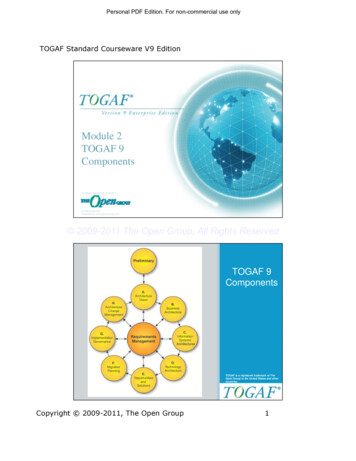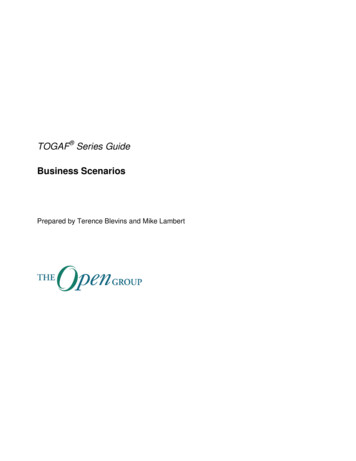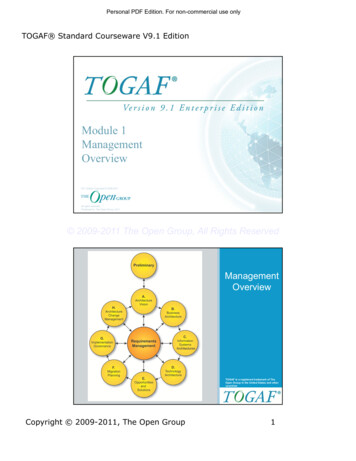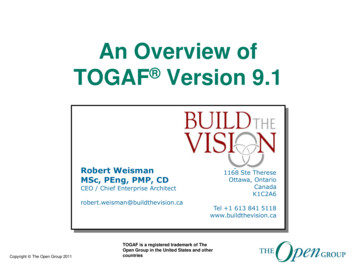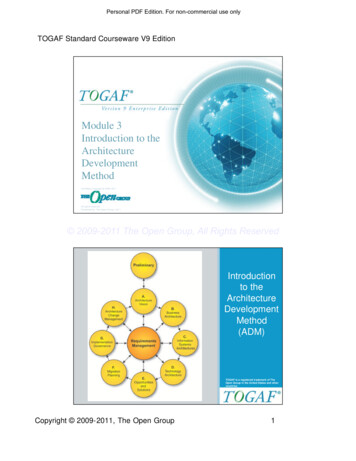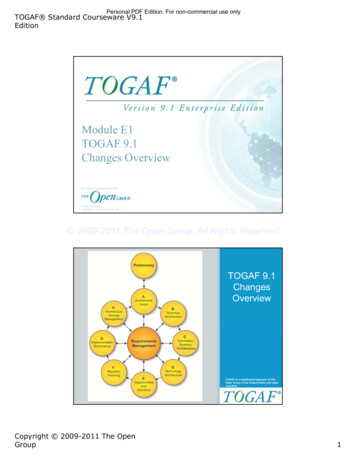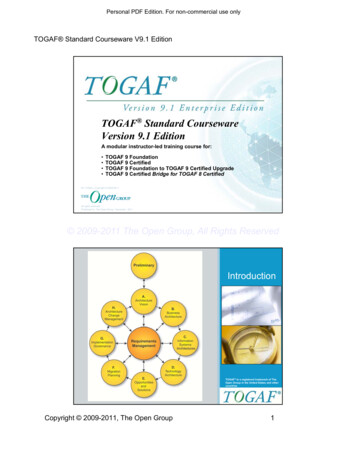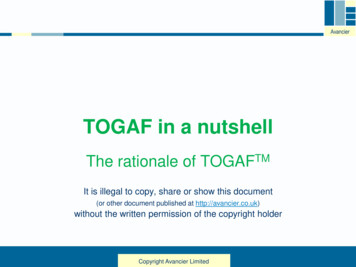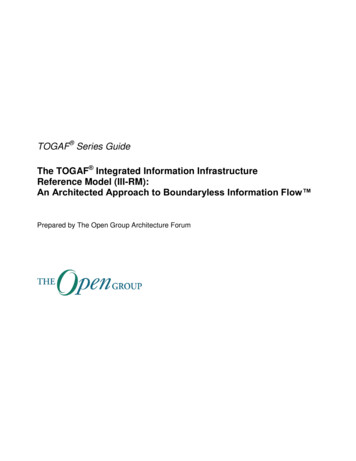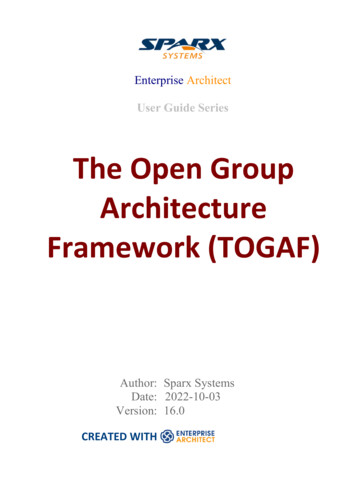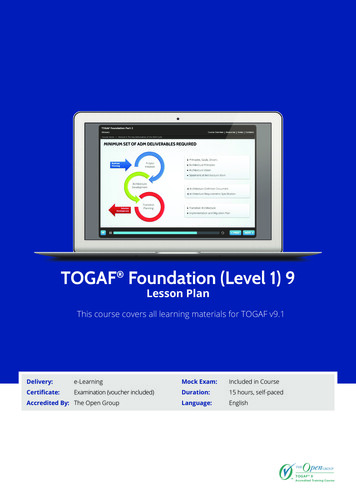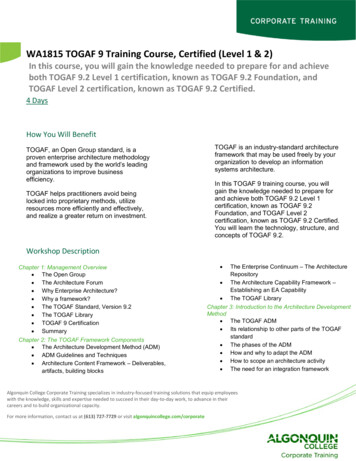
Transcription
WA1815 TOGAF 9 Training Course, Certified (Level 1 & 2)In this course, you will gain the knowledge needed to prepare for and achieveboth TOGAF 9.2 Level 1 certification, known as TOGAF 9.2 Foundation, andTOGAF Level 2 certification, known as TOGAF 9.2 Certified.4 DaysHow You Will BenefitTOGAF, an Open Group standard, is aproven enterprise architecture methodologyand framework used by the world’s leadingorganizations to improve businessefficiency.TOGAF helps practitioners avoid beinglocked into proprietary methods, utilizeresources more efficiently and effectively,and realize a greater return on investment.TOGAF is an industry-standard architectureframework that may be used freely by yourorganization to develop an informationsystems architecture.In this TOGAF 9 training course, you willgain the knowledge needed to prepare forand achieve both TOGAF 9.2 Level 1certification, known as TOGAF 9.2Foundation, and TOGAF Level 2certification, known as TOGAF 9.2 Certified.You will learn the technology, structure, andconcepts of TOGAF 9.2.Workshop DescriptionChapter 1: Management Overview The Open Group The Architecture Forum Why Enterprise Architecture? Why a framework? The TOGAF Standard, Version 9.2 The TOGAF Library TOGAF 9 Certification SummaryChapter 2: The TOGAF Framework Components The Architecture Development Method (ADM) ADM Guidelines and Techniques Architecture Content Framework – Deliverables,artifacts, building blocks The Enterprise Continuum – The ArchitectureRepositoryThe Architecture Capability Framework –Establishing an EA CapabilityThe TOGAF LibraryChapter 3: Introduction to the Architecture DevelopmentMethod The TOGAF ADM Its relationship to other parts of the TOGAFstandard The phases of the ADM How and why to adapt the ADM How to scope an architecture activity The need for an integration frameworkAlgonquin College Corporate Training specializes in industry-focused training solutions that equip employeeswith the knowledge, skills and expertise needed to succeed in their day-to-day work, to advance in theircareers and to build organizational capacity.For more information, contact us at (613) 727-7729 or visit algonquincollege.com/corporate
Chapter F6: ADM Phases Level 1 How each ADM Phase contributes to thesuccess of Enterprise Architecture? Key concepts of the Core Metamodel EntitiesThe components of the TOGAF ContentMetamodelChapter F7: ADM Guidelines and Techniques How to use the TOGAF Framework withdifferent architectural styles The contents of Part III: ADM Guidelines andTechniques – The difference between guidelinesand techniques The use of Architecture Principles The use of Business scenarios in the ADM The gap analysis technique The use of interoperability requirements in theADM The Business Transformation ReadinessAssessment Risk Management in the ADM Capability based planningChapter 8: Preliminary Phase Objectives Approach Steps Inputs OutputsChapter 4: The Enterprise Continuum and Tools Introduction to the Enterprise Continuum The purpose of the Enterprise Continuum The constituent pieces of the EnterpriseContinuum High-level issues with Tool StandardizationChapter 10: Business Scenarios How to apply the Business Scenarios technique Where it is used in the TOGAF standardChapter 5: Architecture Repository The purpose of the Architecture Repository Its constituent parts Its relationship to other parts of the TOGAFstandardChapter 6: Architecture Content Framework Explain the purpose of the Architecture ContentFramework Describe the main components of the ContentMetamodel Describe the relationship between theArchitecture Content Framework and theTOGAF ADMChapter 7: TOGAF Content Metamodel What a metamodel is and why it is needed Key concepts of the Core Metamodel The division of the metamodel into Core andExtensionsChapter 9: Architecture Governance Architecture Governance The main components that make up anArchitecture Governance Framework The TOGAF Architecture GovernanceFramework Architecture Governance in Practice Why Architecture Governance is beneficial Guidelines for establishing an EA CapabilityChapter 11: Stakeholder Management Explain how to apply the stakeholdermanagement technique Understand the steps in developing astakeholder map and how to use the mapUnderstand the benefits for creating views andrelating those to stakeholder and their concernsChapter 12: Architecture Views and Viewpoints To understand the concepts of ArchitectureViews and Architecture Viewpoints To understand the role of Architecture Views To introduce some TOGAF resourcesChapter 13: Building Blocks Concepts of Building Blocks within TOGAF Architecture Building Blocks Solution Building Blocks Their role within application of the ADM A comparison with Architecture PatternsChapter F11: ADM Deliverables Level 1 The role of Architecture Deliverables The purpose of key deliverablesAlgonquin College Corporate Training specializes in industry-focused training solutions that equip employeeswith the knowledge, skills and expertise needed to succeed in their day-to-day work, to advance in theircareers and to build organizational capacity.For more information, contact us at (613) 727-7729 or visit algonquincollege.com/corporate
Chapter F12: TOGAF Reference Models The TOGAF Technical Reference Model (TRM) The Integrated Information InfrastructureReference Model (III-RM)Chapter 14: Architecture Implementation SupportTechniques Managing Interoperability Requirements Business Transformation Risk Assessment Capability PlanningChapter 15 Phase A: Architecture Vision Objectives Approach Steps Inputs OutputsChapter 16 Phase B: Business Architecture Objectives Approach Steps Inputs OutputsChapter 16A Phase B: Business Architecture-Catalogs,Matrices and Diagrams The Catalogs, Matrices and Diagrams of PhaseB, Business Architecture What they consist of How they can be usedChapter 17 Phase C: Information Systems ArchitectureOverview The objectives of Phase C, Information SystemsArchitectures The Approach A brief overview of the inputs and outputsChapter 18 Phase C: Data Architecture The objectives of the Data Architecture part ofPhase C What it consists of What inputs are needed for it What the outputs areChapter 18A Phase C: Data Architecture-Catalogs,Matrices and Diagrams The Catalogs, Matrices and Diagrams of PhaseC, Data Architecture What they consist of How they can be usedChapter 19: The Integrated Information InfrastructureReference Model Describe the business and technical drivers forBoundaryless Information Flow that led to thedevelopment of the Integrated InformationInfrastructure Reference Model (III-RM) Describe the main components of the III-RM Explain how the III-RM was derived Explain the III-RM graphicChapter 20 Phase C: Application Architecture Objectives Inputs Steps OutputsChapter 20A Phase C: Application Architecture-Catalogs,Matrices and Diagrams The Catalogs, Matrices and Diagrams of PhaseC, Application Architecture What they consist of How they are usedChapter 21: TOGAF Foundation Architecture- the TRM The Purpose, Structure and Use of the TRM The Platform Services Taxonomy Application Platform Service QualitiesChapter 22 Phase D: Technology Architecture The objectives of Phase D, TechnologyArchitecture What it consists of What inputs are needed for it What the outputs areChapter 22A Phase D: Technology Architecture –Catalogs, Matrices and Diagrams The Catalogs, Matrices and Diagrams of PhaseD, Technology Architecture What they consist of How they are usedAlgonquin College Corporate Training specializes in industry-focused training solutions that equip employeeswith the knowledge, skills and expertise needed to succeed in their day-to-day work, to advance in theircareers and to build organizational capacity.For more information, contact us at (613) 727-7729 or visit algonquincollege.com/corporate
Chapter 23: Migration Planning Techniques Understand the techniques used in Phases Eand F for Migration Planning Key areas include: Using the Implementation Factor Assessmentand Deduction Matrix to document factorsimpacting the Architecture Implementation andMigration Plan. The purpose of the Consolidated Gaps,Solutions and Dependencies Matrix The purpose of an Architecture DefinitionIncrements table Using the Enterprise Architecture StateEvolution Table with the TRM Using the Business Value AssessmentTechniqueChapter 25 Phase E: Opportunities and Solutions The objectives of Phase E, Opportunities andSolutions What it consists of What inputs are needed for it What the outputs areChapter 25 Phase F: Migration Planning The objectives of Phase F, Migration Planning What it consists of What inputs are needed for it What the outputs areChapter 26 Phase G: Implementation Governance The objectives of Phase G, ImplementationGovernance What it consists of What inputs are needed for it What the outputs areChapter 27 Phase H: Architecture Change Management The objectives of Phase H, Architecture ChangeManagement What it consists of What inputs are needed for it What the outputs areChapter 28: ADM Architecture RequirementsManagement The process of managing ArchitectureRequirements during application of the ADM What it consists of What inputs are needed for it What the outputs areChapter 29: Architecture Partitioning How an overall Enterprise Architecture can bepartitioned to meet the specific needs of theorganization Key learning outcomes: The purpose of Architecture Partitioning The classification criteria for solutions andarchitectures when considering partitioning How Architecture Partitioning can be employedin the Preliminary Phase of the ADMChapter 30: Adapting the ADM – Iterations and Levels How to adapt the ADM using iteration anddifferent levels of architecture engagementChapter 31: Adapting the ADM-Security Obtain an understanding of the securityconsiderations that need to be addressed duringapplication of the ADMChapter 33: Architecture Maturity Models Explain the role of a Capability Maturity Model Explain the CMMI process improvementapproach development by CMU Describe the structure and levels of the ACMMdeveloped by CMU for the US DoC Explain the role of Maturity Assessments in theADMChapter 34: Architecture Skills Framework Explain the purpose of the Architecture SkillsFramework and why it is needed Describe thebenefits of using the Architecture SkillsFramework Describe the structure of the Architecture SkillsFramework, including roles, skills andproficiency levelsAlgonquin College Corporate Training specializes in industry-focused training solutions that equip employeeswith the knowledge, skills and expertise needed to succeed in their day-to-day work, to advance in theircareers and to build organizational capacity.For more information, contact us at (613) 727-7729 or visit algonquincollege.com/corporate
Chapter F13: The TOGAF Certification for PeopleProgram Describe The Open Group Certification forPeople program for the TOGAF StandardUnderstand the levels for certification Understand the paths for certification Understand the requirements for certification* TOGAF is a registered trademark of The Open GroupPrerequisites: A prior knowledge of Enterprise Architectureis advantageous but not requiredAttend This Workshop If You The target audience for TOGAF 9 Certified(Level 1 and 2) training includes but is notlimited to:Individuals who require a deeper understandingof TOGAF 9.2Professionals who are working in anorganization where TOGAF 9.2 has beenadopted and who need to participate inarchitecture projects and initiativesArchitects who will be responsible fordeveloping architecture artifactsArchitects who wish to introduce TOGAF 9.2into an architecture practiceArchitects who want to achieve a recognizedqualification to demonstrate their detailedknowledge of TOGAF 9.2By the end of this workshop, you will beable to: Discuss the basic concepts of enterprisearchitecture and TOGAF 9.2. Discuss the features of TOGAF and itsmethodology. Take best advantage of how to use TOGAF in their work. Gain an understanding of the necessary bodyof knowledge to achieve certification byexamination for TOGAF 9 at Level 1(TOGAF 9 Foundation) or Level 2(TOGAF 9 Certified)* TOGAF 9 Training Course, level 1, level 2and Combined includes Exam Vouchers.Algonquin College Corporate Training specializes in industry-focused training solutions that equip employeeswith the knowledge, skills and expertise needed to succeed in their day-to-day work, to advance in theircareers and to build organizational capacity.For more information, contact us at (613) 727-7729 or visit algonquincollege.com/corporate
How to Register Call (613) 727-7729 Email training@algonquincollege.com Register online:www.algonquincollege.com/corporate Location for Open Enrolment Courses:o Algonquin College Learning Centreo 700 Sussex Drive, Ottawa, OntarioK1N 1K4o Time: 8:30 a.m. to 4:00 p.m.o Check-in, coffee and muffins start at7:45 a.m. Afternoon refreshmentprovided.o Group size is limited to 20. Dedicated sessions are available at our siteor at your location.Algonquin College Corporate Training specializes in industry-focused training solutions that equip employeeswith the knowledge, skills and expertise needed to succeed in their day-to-day work, to advance in theircareers and to build organizational capacity.For more information, contact us at (613) 727-7729 or visit algonquincollege.com/corporate
In this TOGAF 9 training course, you will gain the knowledge needed to prepare for and achieve both TOGAF 9.2 Level 1 certification, known as TOGAF 9.2 Foundation, and TOGAF Level 2 certification, known as TOGAF 9.2 Certified. You will learn the technology, structure, and concepts of TOGAF 9.2. TOGAF, an Open Group standard, is a proven .
